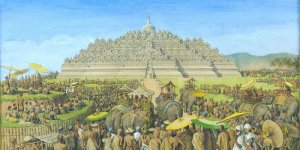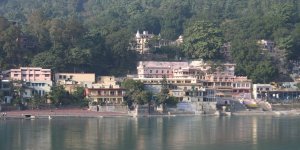| Published in Attractions / Temples, Ashrams, Monasteries |
Yiga Choeling Monastery (Old Ghoom Monastery), Darjeeling, India
Gelug Tradition, 19th century, about 40 monks.
Old Ghoom Monastery, also known as Yiga Choeling, belongs to the Gelugpa or the Yellow Hat sect and is one of the oldest Tibetan monasteries in Darjeeling. It was built in 1850 by the famous Mongolian astrologer and monk Sokpo Sherab Gyatso.

Ghoom Monastery. Photo: Bernard Gagnon, Wikipedia.
Location
Yiga Choeling Monastery is located in Ghoom at an elevation of 2400m, 8 km from Darjeeling in the state of West Bengal.
History
From 1850 to 1905 Sokpo Sherab Gyatso was the head of the monastery. Later he went back to Tibet and died in his native province. Kyabje Domo Geshe Rinpoche Ngawang Kalsang, succeeded Sherab Gyatso as head of the monastery from 1910 until 1952. Like his predecessor, at the end of his tenure he went back to Tibet and died in his native place.
During the Chinese occupation of 1959 of Tibet, many high-ranking monks who fled to India took refuge in this monastery. In 1961 H.H. the Dalai Lama sent H.E Dhardo Rinpoche as the head of the monastery. He passed away in 1990 and three years later, a boy named Tenzin Legshad Wangdi was recognized as his reincarnation.
On 25th April 1996 he was enthroned at Kalimpong Tibetan ITBCI school with monastic custom. The thirteenth in the line of Tulkus, Tenzin Legshad Wangdi, still goes by the name of Dhardo Tulku. At present he is studying Tibetan Philosophy in Drepung Loseling University in South India. Under the supervision of H.E the Dhardo Rinpoche, the Managing Committee was set up in order to uplift the monastery.
Features
The five-meter statue of Maitreya Buddha1 in the shrine hall, commissioned during Domo Geshe Rinpoche tenure, it is the largest and the oldest statue among all the monasteries in Darjeeling. The statue is made up entirely of clay brought from Tibet, mixed with many ground-up precious stones and holy things. Between the eyes of the statue a huge diamond reflects the light of the many butter lamps.

Statue of Maitreya Buddha. Photo: Sandeep Kumar
On the right side of it are three statues of Buddha symbolizing the past, present and future Buddha.
On the left side are images of Domo Geshe Rinpoche and Avalokiteśvara, "the god with 1000 hands, 1000 eyes and 11 heads, the god of love and compassion." 2
Idols of Mañjuśrī 3, Amitābha Buddha4 and Vajrapāṇi or Shakna Dorje5 the wrathful protector, are also in the shrine hall. Just below Shakna Dorje is the idol of Guru Padmasambhava (Guru Rinpoche).
The monastery has a book collection of the Kangyur and Tengyur6 consisting of 102 and 213 volumes respectively.
Festivals
• Tibetan New Year (Losar) commences with the four days of ritual prayer offering and throwing Torma7 to destroy the evil spirits of the earth and thereby to welcome the beginning of the new days wishing happiness and prosperity to all the sentient beings.
• Saga Dawa Düchen - The Birth, Enlightenment and Parinirvāṇa of Buddha.8 This day is the single most important holy day of the year for Tibetan Buddhists. The monastery conducts 16 days of meditation in the name of Avalokiteśvara. In 2021 falls on Wednesday, May 26 and is celebrated from May 12 to June 10.
During the meditation period, the eight Mahayana precepts for 24 hours are followed: take just one meal before noon, drink water or light drinks but not whole milk, thick juice with pulp etc., no conversation (maintain “noble silence”), no combing, no possession of ornaments, no bathing.
In the meditation hall the preaching is done on "love and compassion" by H.E the Dhardo Rinpoche wherein he tries to arouse the humanitarian feelings of the devotees and to commit themselves for the betterment of sentient beings.
• H.H. The Dalai Lama's birth anniversary is celebrated on 6th July, when prayers are made for his long and prosperous life.
• Lhabhab Dhuchen is one of the four Buddhist festivals commemorating four events in the life of the Buddha, according to Tibetan traditions. Lhabab Düchen occurs on the 22nd day of the ninth lunar month according to Tibetan calendar and celebrates the Buddha's descent from the Trāyastriṃśa9 heaven down to earth.
• Ganden Ngamchoe, literally “Ganden Offering of the Twenty-Fifth Day,” or Lama Tsongkhapa Day, is a celebration of the anniversary of Lama Tsongkhapa’s parinirvana. It is celebrated on the 25th day of the 10th month of the Tibetan calendar.
Visiting
Direct flights are available from new Delhi to Bagdogra airport in West Bengal. From the airport, Ghoom Monastery is reachable by car in about two to three hours.
The Yiga Choeling Monastery has witnessed severe crisis both in terms of finance and man power in the last two decades. Due to financial difficulties, presently the monastery is meeting its needs through donations and contributions from local devotees. Visitors are required to pay to take photos or videos inside the monastery.
Sources
• http://yigachoeling.com/index
• https://en.wikipedia.org/wiki/Ghum_Monastery
• https://www.universalcompassion.org/event/saga-dawa-duchen-2021/
Footnotes
1. Maitreya (Sanskrit) or Metteyya (Pali) is regarded as a future Buddha of this world in Buddhist eschatology. In some Buddhist literature, such as the Amitabha Sutra and the Lotus Sutra, the being is referred to as Ajita. According to Buddhist tradition, Maitreya is a bodhisattva who will appear on Earth in the future, achieve complete enlightenment, and teach the pure dharma. According to scriptures, Maitreya will be a successor to the present Buddha, Gautama Buddha (also known as Śākyamuni Buddha). The prophecy of the arrival of Maitreya refers to a time in the future when the dharma will have been forgotten by most on the terrestrial world.
Maitreya currently resides in the Tuṣita Heaven (Pāli: Tusita), said to be reachable through meditation. Gautama Buddha also lived here before he was born into the world as all bodhisattvas live in the Tuṣita Heaven before they descend to the human realm to become Buddhas.
Although all bodhisattvas are destined to become Buddhas, the concept of a bodhisattva differs greatly in Theravada and Mahayana Buddhism. In Theravada Buddhism, a bodhisattva is one who is striving for full enlightenment (Arahantship in Pali), whereas in Mahayana Buddhism, a bodhisattva is one who has already reached a very advanced state of grace or enlightenment but holds back from entering Nirvāṇa so that he may help others. In Mahayana Buddhism, Buddhas preside over pure lands, such as Amitābha over Sukhavati. Once Maitreya becomes a buddha, he will rule over the Ketumati pure land, an earthly paradise sometimes associated with the city of Varanasi (also known as Benares) in Uttar Pradesh, India, and in other descriptions, the Shambhala.
2. In Buddhism, Avalokiteśvara, also called or Padmapani, is the bodhisattva who embodies the compassion of all Buddhas. This bodhisattva is variably depicted, described, and portrayed in different cultures as either male or female. In Tibet, he is known as Chenrezig. In China, Taiwan, and other Chinese communities, Avalokiteśvara has evolved into the somewhat different female figure Guanyin or Guanshiyin, also known as Kannon or Kanzeon in Japan, Gwanseum in Korea and Quan Am in Vietnamese. In Nepal Mandal, this figure is known as Jana Baha Dyah, Karunamaya or Seto Machindranath. He is known as Natha Deviyo in Sri Lanka and Lokanatha In Myanmar (Burma). In Thailand and Cambodia, he is called as Lokesvara.
3. Mañjuśrī is a bodhisattva associated with prajñā (wisdom) in Mahāyāna Buddhism. His name means "Gentle Glory" in Sanskrit. Mañjuśrī is also known by the fuller name of Mañjuśrīkumārabhūta, literally "Mañjuśrī, Still a Youth" or, less literally, "Prince Mañjuśrī". Another name of Mañjuśrī is Mañjughoṣa.
4. Amitābha, also known as Amida or Amitāyus, is a celestial buddha according to the scriptures of Mahayana Buddhism. Amitābha is the principal buddha in Pure Land Buddhism, a branch of East Asian Buddhism. In Vajrayana Buddhism, Amitābha is known for his longevity attribute, discernment, pure perception, and purification of the aggregates with a deep awareness of emptiness of all phenomena. According to scriptures, Amitābha possesses infinite merit resulting from good deeds over countless past lives as a bodhisattva named Dharmākara. Amitābha means "Infinite Light", and Amitāyus means "Infinite Life" so Amitābha is also called "The Buddha of Immeasurable Light and Life".
5. Vajrapāṇi (meaning, "Vajra in his hand") is one of the earliest-appearing bodhisattvas in Mahayana Buddhism. He is the protector and guide of Gautama Buddha and rose to symbolize the Buddha's power. Vajrapāni is extensively represented in Buddhist iconography as one of the earliest three protective deities or bodhisattvas surrounding the Buddha. Each of them symbolizes one of the Buddha's virtues: Mañjuśrī manifests all the Buddhas' wisdom, Avalokiteśvara manifests all the Buddhas' immense compassion, and Vajrapāni protects Buddha and manifests all the Buddhas' power as well as the power of all five tathāgatas (Buddhahood of the rank of Buddha).
6. The Tibetan Buddhist canon is a loosely defined collection of sacred texts recognized by various schools of Tibetan Buddhism, comprising the Kangyur or Kanjur ('Translation of the Word') and the Tengyur or Tanjur (Tengyur) ('Translation of Treatises').
7. Torma (Skt: Balingta, Tib: Tor-ma) are figures made mostly of flour and butter used in tantric rituals or as offerings in Tibetan Buddhism. They may be dyed in different colors, often with white or red for the main body of the torma. They are made in specific shapes based on their purpose, usually conical in form. A very large, central shrine torma may be constructed for festivals, though typically they are small and placed directly on a shrine, on a plate, mounted on leather or held on a special base like a skull.
8. Saga Dawa, or Vesak, is known as the month of merits; it’s also called bumgyur Dawa, which means “merits multiplied by a hundred thousand times.” Tibetan Buddhists worldwide make extra efforts in practicing Dharma, generosity, and compassion to accumulate greater virtuous merits and purify our negative karmas. Along with remembering Buddha and his activities, the festival’s main point is to pray. Many say the goal of the festival season is to pray for the long life of all holy Gurus from all traditions, for the survival and spreading of Buddha’s teachings in the minds of all sentient beings, and peace on earth. Tibetan Buddhists go to monasteries and temples to pray during the Saga Dawa Festival.
9. The Trāyastriṃśa (Sanskrit; Pali Tāvatiṃsa) heaven is an important world of the devas in the Buddhist cosmology. The word trāyastriṃśa is an adjective formed from the numeral trayastriṃśat, "33" and can be translated in English as "belonging to the thirty-three devas". It is primarily the name of the second in the six heavens of the desire realm in Buddhist cosmology, and secondarily used of the devas who dwell there. Trāyastriṃśa is ruled by Śakra. According to legend, the Buddha ascended the Trāyastriṃśa heaven temporarily at the age of 41, to give teachings to benefit the gods in that desire realm, and to repay the kindness of his mother by liberating her from Samsara.
YOU MAY ALSO LIKE





 If you own or manage a travel-related business such as a hotel, a bed-and-breakfast, a restaurant, a pub or a cafeteria, you can create a web page for your business for free on Titi Tudorancea Travel Info. » |
